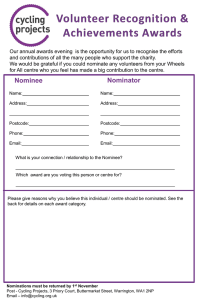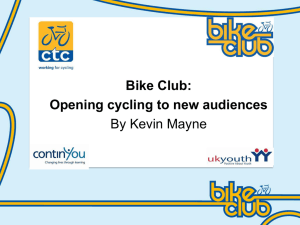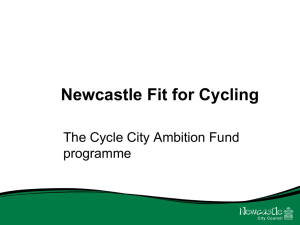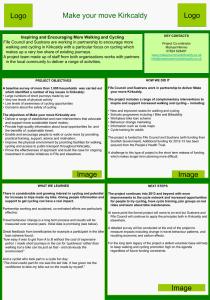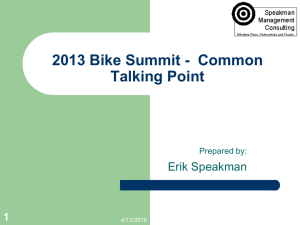Presentations - Sound Cyclists Bicycle Club
advertisement
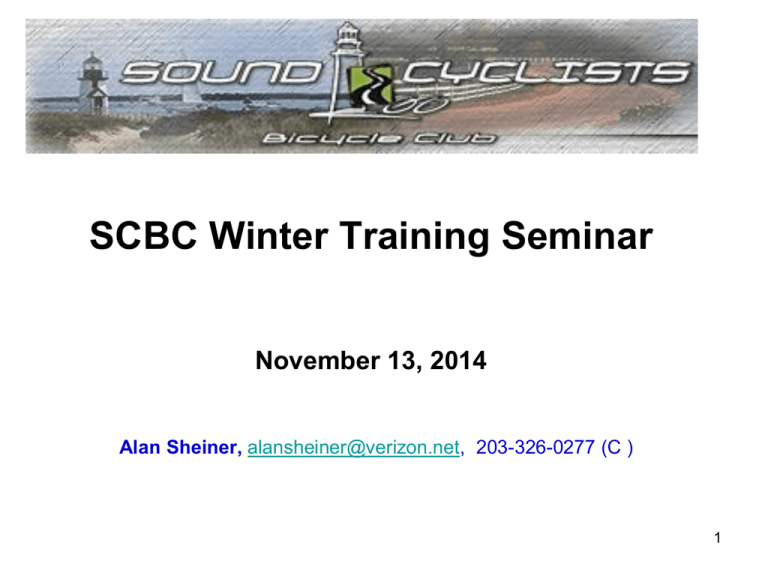
SCBC Winter Training Seminar November 13, 2014 Alan Sheiner, alansheiner@verizon.net, 203-326-0277 (C ) 1 Winter Training Seminar Agenda Subject Speaker Winter cycling training considerations Alan Sheiner (6:45-7pm) The Art of Performance Eneas Freyre (7-7:20pm) Symptoms, causes, treatment and prevention of overuse cycling injuries Gloria Cohen (7:20-7:40pm) Nutrition and Weight Control Lois C. Duke (7:40-8pm) Conservative Treatment for Overuse Injuries in Cycling David Potucek (8-8:20pm) SCBC sponsored winter cycling programs Alan Sheiner SCBC Cycling Showcase SCBC members (8:20-8:30pm) Raffle Note: Everything that follows in this seminar is just a general outline of suggestions, not intended to be specific advice for anyone. Always consult your trainer and/or physician before embarking on any regime. 2 Speakers Eneas Freyre, Owner & Head of Training at TTEndurance,. As one of the first coaches in Fairfield County to introduce a formal and systematic indoor cycling and running program, Eneas Freyre has been refining indoor cycling and running training for almost two decades. Adapting principles from his real world training experience as an elite cyclist and runner, Eneas has shown that a disciplined indoor program can provide great training adaptations that have a profound effect on outdoor performance. In his own right, Eneas has leveraged his indoor programing skills to garner continued success in his own athletic career, claiming local, regional, and world level successes. He credits this indoor training methodology for helping him win an overall Duathlon World Championship in 2011 and a 3rd place finish in the prestigious Mt. Washington bicycle hill climb in 2014. As a coach, Eneas strives to bring out the Champion in all of his athletes. Gloria Cohen, MD, FACSM, a sports medicine physician with Orthopaedic and Neurosurgery Specialists, is the former Team Physician for the Canadian National and Olympic Cycling Teams and is currently the Primary Care Sports Medicine Team Physician at Columbia University. Dr. Cohen was a featured speaker at the Medicine of Cycling Conference in Colorado Springs. Lois C. Duke, MS, RD, CDE, CSSD,CDN is a Registered Dietitian with a Master’s Degree in Nutrition from Columbia University. She is also a Certified Diabetic Educator from the National Certification Board of Diabetic Education and a Certified Dietitian-Nutritionist with the State of Connecticut as well as a Certified Specialist in Sports Dietetics. She has an additional Certification in Adult Weight Management from the Commission on Dietetic Registration. She has been a dietitian for nine years and has worked in a variety of healthcare settings and with a variety of medical conditions including Kidney and Liver Transplant, Heart Disease and Transplant, Gastrointestinal Diseases and Geriatrics. Currently, she is Principal Dietitian and Diabetes Educator at The Stamford Hospital Diabetes and Endocrine Center in Stamford, Ct and Sole Proprieter of Full Circle Health & Wellness in Westport,CT David Potucek, MSPT, CFMT, is a physical therapist with Elite Health Services. Dave has worked in a variety of practice settings, treating a multitude of orthopedic, sports, and neurological patient populations. His experience as a personal trainer further develoed his knowledge of exercise based strength training. 3 SCBC Mission o Sound Cyclist Bicycle Club provides organized rides and other cycling related activities for our members and the community, which stress safety, fun and fitness for all levels of riders. o The club also provides the opportunity for cyclists to improve their riding skills. The club is an advocate of safe cycling in Fairfield County and the State of Connecticut. 4 Winter Training Consideration • Off season program can maintain the aerobic base you have built during the spring/fall regular outdoor cycling season. • A good winter program will maintain a foundation or base for the ramp up that will come with your next spring a more fit and stronger rider. • Taking some time off the bike can be an ideal way to recharge your batteries and rekindle your love for cycling, although fitness can start to drop after just two weeks of inactivity – and will take nearly three times as long to recondition – Complete rest from exercise isn't a good idea. 5 Winter Training Consideration • A balanced off season program should contain: • Indoor cycling or spin classes, other cross training aerobic sports such as swimming, skiing, treadmill, rowing • Outdoor cycling, when weather / road condition permits • Core and Resistance (weight) training • Nutrition and Weight Control • Take a break every fourth week - You should do less than half of your normal training during this period, and make sure you have at least two days off. •A regular easy week gives you a chance to recover, so that your body can super-compensate for all the training you’ve done. Remember it’s during periods of rest that your fitness improves, not during training itself. 6 Road Safety and Bike Maintenance Bicycle Maintenance • Winter is tough on bike - sand, salt and debris on the road make it hard to keep your chain and derailleur free and working. Gears tend to get mucked up fast. • Clean it off periodically with a cloth and make sure to dry off the chain too. • Be sure to keep the chain lubed. • Tire Pressure. Decrease the amount of air pressure in tires for riding in winter. You will get better floatation. Safety • Motorists don’t expect cyclists to be out on roads in wintertime. In order to be safe, you must be visible. • Motorists often have limited visibility in winter: low‐lying sun in their eyes, ice, frost, or snow may obscure their view and accumulated dust on windshield. • Your outer layers should be bright and reflective. 7 Road Safety and Bike Maintenance Bicycle Gear Lights are a must. They serve two purposes: to help you see the path, and to help others see you. • • At a minimum, have a white blinking light facing forward and red blinking light facing backward. • Mount your lights at a height where drivers can see you from a far distance Away. • A light mounted to your helmet serves two purposes. It lights up whatever you look at, and it easily catches the attention of drivers. When you look at their car, the head lamp lights up the inside of their vehicle. It’s a powerful combination to have both a head lamp and the strobe. • Lighted and reflective arm and leg bands will help you be seen from the sides. • Reflective tape placed on your bike frame can also help drivers see you from all •directions. • Helmets. Some winter commuters like using ski helmets, as they provide extra warmth. 8 Road Safety and Bike Maintenance Riding Tips • Bikes rarely slip when they are going in a straight direction. Take care on corners. • When approaching a stopping point that is potentially slick/icy, for example: an intersection, take care when putting your foot down. Sometimes while riding it is easy to forget the underlying surface can be slippery. • Watch out for leaf-strewn areas on lanes – wet leaves can create seriously slippery surfaces. • If you’re riding in a group in these sorts of conditions, leave a little more room between you and the guy in front, and try to anticipate any problems that might occur up ahead. • Look ahead: Everyone’s vision tends to be reduced in winter, especially in the early morning and in the late afternoon. 9 Road Safety and Bike Maintenance Lane Position • In winter, one of the most dangerous places to ride is right up next to the curb. • The immediate curb area is where snow accumulates, gets plowed over, melts, freezes and generally becomes an uneven mess of ridges, road debris and ice. Seek out the pavement or just far enough away from the curb to stay off of this dangerous mix. • In wet or cool conditions, the immediate curb area is where broken glass, bits of rusted metal from cars and general road debris build up as the rain washes it to the shoulder. 10 Winter Cycling Clothing • Head covering - You can lose up to 25% of your body heat through your head. Keep your head covered and you'll keep your core warm. • Base: A moisture-wicking baselayer that keeps the body dry is crucial. Wear an extra thin layer rather than one that’s too thick. • Mid: A thermal layer worn over your baselayer will keep the warmth in, but should work with the base and shell to let sweat vapour out. • Vest - Thin, lightweight, but it'll help protect your core from the wind. • Shell: Softshell and waterproof jackets should provide wind stopping coverage to the belly, chest and groin – core areas you need to keep warm. • Legs: Wear leg warmers or knee warmers under your cycling short's leg. Full-length bib tights /or Windproof tights an essential under colder weather. keep your hands and feet warm - Best are cycling gloves with grippy palms and fingers. • Toe covers / Booties - extremities don't get good blood flow when the arteries clamp down with the cold, so protect those toes. A good rule of thumb is to go a half size bigger with your shoes. 11 Winter Cycling Clothing What to wear with your shorts, socks, helmet and glasses, When the temperatures are less than balmy: • 40-50 degrees: base layer, long-sleeve wind-proof jersey, full-length leg warmers, cycling cap or skullcap, full-finger gloves, insulated booties (optional) • 50-60 degrees: base layer, long-sleeve jersey or jersey and arm warmers, knee warmers, shoe covers (optional) • 60-65 degrees: base layer, jersey and arm warmers, knee warmers • 65+ degrees: base layer, jersey Note: From "Pack like a pro", by Chris Carmichael, "Bicycling" May, 2006, page 48 12 The Art of Performance TTEndurance 772 Post Rd. East 2nd FL Westport, CT 06880 13 14 15 16 17 18 19 20 21 Cycle Strong! Sports Medicine Gloria C. Cohen, MD November 13, 2014 22 Sports Medicine • The practice of medicine as it applies to all aspects of physical activity in healthy and diseased states and in altered physiological or environmental conditions. 23 Musculoskeletal Presentations • Overuse injuries • Traumatic injuries 24 Common Cycling Overuse Injuries • Pedals • Seat • Handlebars 25 Common Causes of Overuse Injuries • Overtraining • Muscle imbalance • Inflexibility • Cycling technique • Bike fit 26 Lower Extremity Anatomy & Biomechanics • • • • • Important relationships in cycling Biomechanical malalignment Patellar tracking Pronation and supination Muscle imbalance 27 Pronation & Supination 28 Common Knee Injuries • Patellofemoral pain syndrome (PFPS) • Iliotibial band syndrome 29 Vastus medialis 30 “Biker’s Knee” • • • • Patellofemoral pain syndrome Inadequate quads/hamstring muscle balance Biomechanical malalignment Training errors • • • • • • Knee pain Positive theater sign Rarely swelling Squinting patellae Medial tenderness Positive compression test 31 Rule of the Road • “If the knees hurt, gear down” • Considerable compressive force is transmitted to the knee joint in cycling 32 PFPS Treatment • Stretching and Strengthening exercises • Taping • Modification of activity • Pain management • Orthotics 33 Iliotibial Band Syndrome • Results from friction • Ache over lateral aspect of knee • Tender ~1-2 cm above lateral jt line • Positive test on examination 34 Treatment of ITBS • • • • • • • NSAIDs PT modalities Massage therapy Stretching and Strengthening exercises ITB strap Injection – corticosteroid; PRP Correction of predisposing factors – training techniques; biomechanical abnormalities 35 Achilles Tendinitis • • • • • Commonest overuse ankle injury Too low a saddle Improper technique Inadequate warm-up Biomechanics 36 Treatment of Achilles Tendinitis • • • • • Adjusting the seat height if necessary Modifying pedaling technique Proper footwear Heel pads in footwear Stretching and strengthening program • PRP injection • Avoid steroid injection 37 Stretching 38 Seat Contact • Ischial bursitis “sit bones” • Watch for leg length discrepancy 39 Handlebars Contact “Cyclist’s Palsy” • Neck pain 40 Head Injuries • Importance of the use of an approved helmet • Replace the helmet if a significant impact occurs 41 Know Your Sweat Rate • Weigh yourself before and after exercise • Losing 2% of your body weight in fluid can affect your performance • Know your sweat rate 42 Warning Signs of Dehydration • • • • • • • • Intense thirst Muscle cramps Weakness Decreased performance Headache Nausea Fatigue Dizziness 43 ACSM Position Statement • Recommends an intake of 0.5 to 0.7 g sodium per liter of water in events longer than 1 hour 44 Prepare Yourself 45 Be Prepared 46 There Is No Free Ride 47 48 Finding Our Way Back: 12 Steps to Better Nutrition and Health Lois C. LoisC. Duke, Duke, MS,RD,CSSD,CDE,CDN MS,RD,CDE,CDN Winter Winter Training Training Seminar Seminar SoundCyclists SoundCyclists Bicycle Bicycle Club Club November November 7, 7, 2013 2013 “In the United States, 80% of girls have been on a diet by the time they are 10 years old”—Sandra Aamodt, Neuroscientist • Combined, 69% of Americans are overweight and/or obese • 40% of Women and 36% of Men go on a diet each year-most will gain the weight back. • Experts estimate roughly 60-70% of foods in the US are processed. • The CDC has stated that 75% of healthcare spending goes to treating preventable chronic diseases, most of which are diet related. In this country, we have lost touch with healthy eating and whole nutritious foods. We are surrounded by processed foods and obsess too much on dieting and food fads as our rates of chronic diseases such as diabetes and heart disease soar. How do we find our way back? 50 Your 12 Step Program to Better Nutrition and Health Lois C. Duke, MS, RD,CDE,CSSD, CDN REGISTERED DIETITIANNUTRITIONIST,CERTIFIED DIABETES EDUCATOR AND CERTIFIED SPECIALIST IN SPORTS DIETETICS 51 Step #1 STOP DIETING Seven habits of highly effective weight loss and maintenance-source the National Weight Control Registry 1.The participants consume a low-kilocalorie, low-fat diet. The participants consume 1,300 to 1,680 kilocalories per day, 25% of which are from fat. 2. The participants have a consistent food intake from day to day, and they eat about four to five times per day. 3. The participants consistently eat breakfast. • • • Evidence indicates that up to 98% of dieters regain lost weight after 5 years and 66% regain after 1 year Diets do not focus on LONG TERM AND SUSTAINABLE BEHAVIOR CHANGES –the “meat and potatoes” of losing and sustaining weight loss. Diets often focus on restriction of foods or fads most frequently not based in any valid scientific evidence 4. The participants are very physically active. The average person in the database exercises for about 60 to 90 minutes per day at moderate intensity. If they choose to walk, they take about 11,000 to 12,000 steps per day, which is the equivalent of almost 6 miles. 5. The participants frequently weigh themselves— weekly or even daily. 6. The participants limit their television viewing to less than 10 hours per week. 7. The participants do not allow even a small amount of weight gain to occur without corrective action. 52 Step # 2 Eat Regularly • Eating regular low fat meals reduces total and LDL (bad) cholesterol and reduces resistance to insulin – reducing the overall risk of developing heart disease. • Regular meal eaters tend to have a lower energy (calorie) intake compared to those who eat irregularly – crucial if you’re looking to maintain or lose weight. • By eating regularly (meals and snacks) you will help keep your blood sugar levels stable. Why is this good? Because this will help prevent strong feelings of hunger, which could result in you over-eating the next time you eat (which is usually the time you reach for that chocolate bar, latte or muffin - or all 3!). 53 Step # 3: Avoid Added and Concentrated Sugars! Reasons to avoid added sugars • Sugars (Honey, Cane Sugars, HFCS, Brown rice syrup) all provide large amounts of fructose which can only be metabolized in the liver– excesses of fructose in the liver will convert to fat. The exception is WHOLE FRUIT— which contain vitamins, minerals, fiber and are difficult to overeat on. • No vitamins or minerals • Empty calories leads to obesity…. Leading to insulin resistance and diabetes • Does not promote satiety • Can be addictive Tips: • Avoid packaged processed foods• Avoid sugar sweetened beverages and juices (eat the whole fruit instead) • Avoid added sugars in foods… this includes cane sugar, brown sugar, brown rice syrup, agave syrup, and honey-- be careful.. They hide everywhere! Examples… granola and granola bars, cereals…… • Eat foods like plain yogurt with fruit instead of fruited yogurt… • You should have no more than 6 teaspoons per day of added sugars. 54 Step#4: Eat WHOLE foods, I mean REALLY Whole foods! • Choose whole grains like bulgur, spelt, oats, quinoa and others • Legumes-black beans, kidney and more • Whole fruit (NOT JUICE) • Whole fresh or frozen vegetables • Fresh lean sources of protein including Fish, Chicken and non animal sources such as tofu • Heart healthy oils like Olive oil and Nuts • Whole foods should have most of their original parts intact. • The closer to the field, the better off you are! 55 STEP #5: Eat local—know your farmer! Food is inextricably linked to our community and our local farming community Get to know your local farmer.. They grow healthy, exciting foods to enjoy and increase your nutritional health. We have many in Ct. Try Community Support Agriculture, farmer’s markets and visit your farmer… know who grows your food. 56 Step # 6: Keep Moving! Be active-on the bike and off! Remember! Exercise and physical activity is not just about the cycling you do before or after work or on weekends. Regular physical activity has many benefits including • • • • • • • • • • • Consider ways you can also keep moving outside of your regular workout… such as trying to keep Reduces the risk of dying prematurely. Reduces the risk of dying from heart disease. 10,000 steps a day, walking around Reduces the risk of developing diabetes. the block during lunch or taking Reduces the risk of developing high blood the stairs. It is important that we pressure. move beyond our isolated Helps reduce blood pressure in people who workouts! already have high blood pressure. Reduces the risk of developing colon cancer. Reduces feelings of depression and anxiety. Helps control weight. Helps build and maintain healthy bones, muscles, and joints. Helps older adults become stronger and better able to move about without falling. Promotes psychological well-being. 57 Step #7: Try that Scary Vegetable….. • Don’t just eat a rainbow every day, CHANGE the rainbow too! • Trying new foods expands your diet, making it more interesting and widening your nutrition sources. • Find a recipe with something you’ve never had, or been scared to try, learn how to prepare it, enjoy! 58 Step #8 Plan Ahead • Planning ahead is an eating behavior that can make a big difference in improving your overall nutrition intake. • Planning ahead reduces the chance of last minute poor nutrition choices and enables one to choose healthier foods without stress! Tips for planning ahead • Sit down and think about the week ahead, plan some meals and snacks • Create a “smart” shopping list and have the food available around the house. • Plan and make lunches for work the night before instead of buying it out. • Create a few “go to” meals for last minute • Check out restaurant menus ahead of time when eating out….. 59 Step # 9 Cook! And if you don’t, Learn how (at least a little bit.) • You don’t need to be a chef to prepare good healthy food. • Cooking connects you to the food you eat, enabling you to fully enjoy your food and appreciate it. That’s part of nutrition and healthy eating. • If you’ve never cooked before, there are ample opportunities to learn how to prepare simply healthy foods! • We should all have some ability to prepare food… 60 Step # 10 Practice Mindfulness and Mindful Eating…. (what?!) • Mindful or Intuitive eating has it roots in Buddhist teachings and aims to raise one’s consciousness around food and eating • Goal is to base our eating on physical cues from our body, rather than emotional ones. • Focus on the Why? When? What? How? How Much? and Where? of eating Simple ways to begin mindful eating • Eat Slower • Savor the Silence • Silence the phone/no TV • Pay attention to flavor • Know your food-create a relationship 61 Step #11 Go to bed & Get your Zzzzzzz’s Poor sleep and sleep deprivation result in changes in hormones involved in appetite regulation leading to an increased consumption of carbohydrate foods (aka-the chocolate bar you ate at 2pm at work today) . Tips for healthy sleep and good sleep hygiene • Go to bed at the same time every night • Don’t take naps after 3 pm –especially, don’t fall asleep At night in front of the TV • Remove TV’s and other distracting items from the bedroom • Avoid caffeine at night • Avoid eating a large meal right before bed. 62 Step # 12 Learn to treat and enjoy yourself! Learning to enjoy and treat yourself is an Important part of a healthy eating plan. Denying yourself only leads to feelings of restriction and ultimately, leads to more destructive eating. Aim to balance your healthy eating plan and your special occasions and/or treats. 63 In Summary…… we do not aim to live to eat or eat to live…. It is not a choice between the two… it is a balance of both. Eat to Live Live to Eat 64 Conservative Treatment for Overuse Injuries in Cycling David Potucek MSPT, CFMT 65 A Comprehensive Approach to Conservative Treatment • Need to look at multiple links of the chain • Is your body free of tightness? Mechanical • Do your muscles fire properly? Neuromuscular • Do you have smooth coordinated movements? (graceful movement) Motor Control • Do you have Strength and Endurance? • How can we allow tissues to heal? De-loading 66 Tensional Integrity Tensegrity – A structure that is held together by a balance between tension and compression. 67 Tensional Integrity 68 69 1) Find Primary Driver • Find the actual cause of pain not the effect • Don’t just treat the effect (back pain) • Treat the cause (tight hip, seat too high) 70 2) Restore Mobility to joints and soft tissues • Think: “Release what’s not moving, stuck, stiff or tight” 71 How Do We Improve Mobility? • • • • Soft Tissue Mobilization Joint Mobilization Visceral Mobilization Neural Mobilization 72 Soft Tissue Mobilization • Hands-on mobilization of soft tissues, i.e., muscle, tendons, ligaments and fascia • Tissue can be scarred/dehydrated 73 Joint Mobilization • Mobilization to the joints to restore normal joint mechanics • Think “Duct Tape around joint” 74 Visceral Mobilization • Hands on techniques to restore the ability of the organs to slide on each other • With a deep breath your organs can move up to 4 inches 75 Nerve Mobilization • Nerves need to slide in channels/grooves to have good mobility • Think “Brake Cable” 76 3) Retrain Neuro-Muscular Control • Think: “ What’s not awake and firing locally” and Re-Connect / reload brain software 77 3) Retrain Neuro-Muscular Control • Homunculus Finger tape research 78 3) Retrain Neuro-Muscular Control • “Must activate the muscles, at the right time, by the right amount, in the correct sequence, and turn off the muscle appropriately” – Bob Donatelli PhD PT 79 How Do We Do Retrain Neuromuscular Control • PNF - Proprioceptive Neuromuscular Control • Progression of contraction types: • Isometric-> isotonic • Slow to fast • Lots of feedback (visual, verbal, kinesthetic) 80 Why Core for Cycling? • Cannon/Battleship 81 4) Global Neuromuscular Control – Motor Control • Teach efficient integrated movement strategies across multiple joints in functional movements • “Looks graceful” or “Good form” 82 5) Strength/Endurance • Test for and train single and multi-joint muscle weakness • If you add strength on top of dysfunction, all you get is a lot of strong dysfunction – Gray Cook PT 83 6) Take Stress off Healing Tissues as Needed Accommodate with: • Bike fit • Training: load, intensity and distribution of hours • Gears / Cadence (Small ring/Big cog) • External Support (Orthotics, Taping / Bracing etc.) 84 6) Take Stress off Healing Tissues as Needed • Don’t forget about off of the bike! 85 Now a case study to demonstrate the principles 86 Knee Pain Case • 1. Find Primary Driver • Effect: Right Knee Iliotibial Band Pain • Cause: mobility/motor control strategies of pelvis/lumbar spine 87 Right Left 88 Left Right 89 2. Mobility Loss • Where: Top up or bottom down? • Foot, hip, thoracic spine, knee, other? • Treatment • Clinic: Joint mobilization, soft tissue mobilization at hip/pelvis • Home: Foam rolling and active stretching 90 3. Local Activation/Neuromuscular Control • Core muscles (deep psoas, transverse abdominis) and hip rotators • Clinic: hands on activation (PNF) • Home: Therapeutic exercises including the abdominal series, heel squeezes, weight acceptance 91 4. Integration -Global Motor Control Off Bike • • • • Use kinesthetic and Visual Feedback Reverse lunge into riding position Sitting in base of support Sit to stands 92 Right Left 93 4. Integration -Global Motor Control On Bike • Kinesthetic awareness with isometrics, feeling the foot, relax the hip, feel sitbones • Mirror with tape, bike bag for tracking • Spin scan on Computrainer R/L 94 5. Strength/Endurance • Lunges/Step ups with weight (in cycling position) • Leg Presses • Cadence and Power work on bike 95 6. Take Stress off Healing Tissues • Accommodated Bike fit • Increase Cadence/ Higher Gears (Force) • Training load (hours) / Intensity (power) 96 Summary • 1. Find the driver (cause/effect) • 2. Make the tissues/joints mobile • 3. Learn to move the body part (Reload software) • 4. Learn to move the chain/system gracefully • 5. Improve strength and endurance • 6. Accommodate where necessary (De-Load) 97 Thank You 98 Navigation of Winter Training Programs o There is a “winter Training” link on SCBC website http://www.soundcyclists.com/ o There are 4 Winter Training SCBC sponsored cycling programs. Time slots are available for SCBC members to participate, beginning Monday, December 1, 2014. o For more information on each program, contacts prices and registration click on the providers name. These programs are offered at a discount to the public price. 99 • Back Ups 100 Raffle Prizes EHS, Greenwich Pacific Tri, Stamford Podium, Norwalk TTEndurance, Westport Sherpa Norwalk Pizza and Pasta 101
